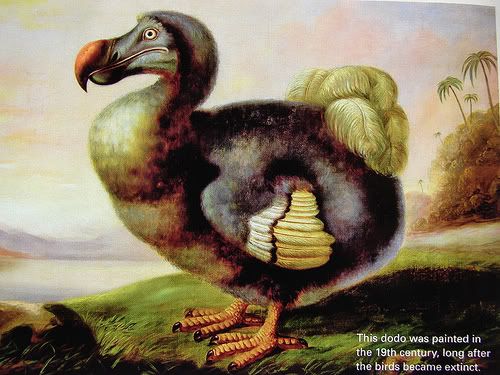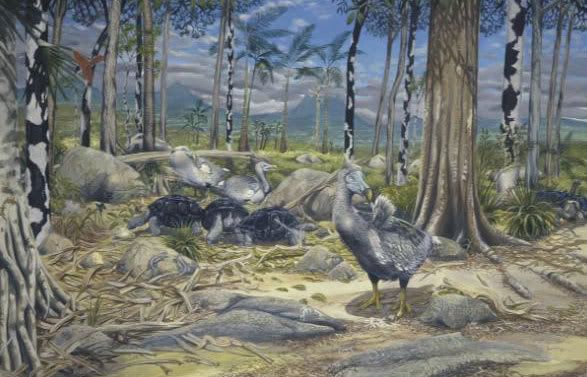|
|
Post by another specialist on Feb 6, 2007 18:41:52 GMT
|
|
|
|
Post by another specialist on Feb 6, 2007 18:49:25 GMT
|
|
|
|
Post by another specialist on Feb 6, 2007 19:06:14 GMT
|
|
|
|
Post by another specialist on Feb 6, 2007 19:39:33 GMT
|
|
|
|
Post by another specialist on Feb 6, 2007 19:41:10 GMT
|
|
|
|
Post by another specialist on Feb 6, 2007 20:54:31 GMT
 Raphus cucullatus, the dodo bird, became extinct in 1667. This is a photo of a picture in the August, 2006 National Geographic Magazine, copyright National Geographic Society. EcoSnake photo by Garren Evans. A great read is "The Song of the Dodo, Island Biogeography in an Age of Extinction" by David Quammen. flickr.com/photos/ecosnake/212176142/ |
|
|
|
Post by RSN on Mar 11, 2007 23:06:02 GMT
Here a pdf with the pages about the ''White'' dodo from Réunion, from the book Dodologia. geocities.yahoo.com.br/rsn_bioteca/Dodologia_trecho_dodo_branco.pdfI know it's probably invalid, but cames here as a curiosity. Also mention eels and tortoises. A bad mention, by the way. How I hate that pirates... The doc is in portuguese, but I think Spanish speakers will can read it fine. |
|
|
|
Post by Peter on Mar 17, 2007 9:08:43 GMT
Thanks for posting it. I've downloaded it...now I have to translate it.
|
|
|
|
Post by RSN on Mar 24, 2007 19:34:20 GMT
Hope you can post it in English here. Thinking about dodo evolution, I always imagined if is not possible to discover ancestral dodo species in the islands. Did the family is poyfiletic? Here a hypothetycal quickly made picture showing how I imagine the two species evolution (the first grey dove is the common ancestor):  Here, the pictures for my book project:  The images are also avaliable in my deviantArt account ( rsnature.deviantart.com). |
|
Deleted
Deleted Member
Posts: 0
|
Post by Deleted on Mar 25, 2007 11:50:37 GMT
Hey, very very impressive !!!  |
|
|
|
Post by RSN on Mar 25, 2007 14:27:08 GMT
Thank you, Noisi!
|
|
|
|
Post by sordes on Mar 25, 2007 15:26:22 GMT
Yes, really nice artork!
|
|
|
|
Post by RSN on Mar 25, 2007 16:27:56 GMT
Thanks Sordes! ^^
|
|
|
|
Post by Carlos on Mar 25, 2007 21:24:26 GMT
Congratulations Rafael. Very good!!!
|
|
|
|
Post by another specialist on Mar 26, 2007 7:23:35 GMT
Yes, Rafael same from me keep up the good work
|
|
|
|
Post by RSN on Apr 1, 2007 2:53:48 GMT
Thanks!!
|
|
|
|
Post by Peter on May 12, 2007 8:52:52 GMT
Very good painting! I especially that one of the Rodriguez Solitaire. Here some news: Dodo bones from Mauritius in LeidenThe dodo bones that were excavated in Mauritius in June 2006 are today presented to the general public in National Museum of Natural History (Nationaal Natuurhistorisch Museum Naturalis) in Leiden, the Netherlands. The presentation takes place during an international symposium on the progress of the research of the dodo mass grave in Mauritius. This mass grave was discovered in 2005 by Dutch researchers. Visitors of the Museum can see the bones from 12 May 2007. The bones consist of the beak, leg bones and some parts of the hip, toe bones and vertebra. Because of the spectacular finds the researchers still expect to find complete dodo skeletons in the same excavation area in Mauritius. That is why a new expedition to Mauritius will be organized in August 2007. Soure: www.naturalis.nl |
|
|
|
Post by another specialist on Jun 4, 2007 7:05:52 GMT
 Fig. 3. Dodo Raphus cucullatus, giant tortoise and the Mare aux Songes before man.(Julian Hume) The dodo is easily the most famous bird in the world yet practically nothing is known about it in life. Large amounts of fossil material were collected in 1865, 1889 and some years after from the Mare aux Songes, but no articulated (bones coming from the same individual) were ever recorded. In the first week of the Mare aux Songes excavation, an articulated leg of the dodo was discovered which indicates that more may be found. Dutch Chief Lamotius, who was stationed on Mauritius from 1677 to1692, last mentioned the dodo in 1688 and presumably it died out shortly after. www.naturalis.nl/asp/page.asp?alias=naturalis.nl&view=naturalis.nl&id=i000256&frameurl=http%3A%2F%2Fwww.natura lis.nl%2Fget%3Fsite%3Dnaturalis.nl%26view%3Dnaturalis.nl%26id%3Di001200%26logId%3Dl000024%26execute%3Dshowsingleitem tinyurl.com/396oxo |
|
|
|
Post by Melanie on Jun 30, 2007 23:35:02 GMT
Scientists in raptures over flightless Fred
Fri 29 Jun 2007, 14:09 GMT
By Ed Harris
BOIS CHERI, Mauritius (Reuters) - The remains of a dodo found in a cave beneath bamboo and tea plantations in Mauritius offer the best chance yet to learn about the extinct flightless bird, a scientist said on Friday.
The discovery was made earlier this month in the Mauritian highlands but the location was kept secret until the recovery of the skeleton, nicknamed "Fred", was completed on Friday. Four men guarded the site overnight.
Julian Hume, a palaeontologist at London's Natural History Museum, told Reuters the remains were likely to yield excellent DNA and other vital clues, because they were found intact, in isolation, and in a cave.
"The geneticists who want to get their hands on this will be skipping down the street," he said, after bringing the last of the remains to the surface.
Given the nickname "Fred" after the 65-year-old who found them, the remains should provide the first decent specimens of dodo DNA, he said.
"Then you can work out how it actually got to Mauritius, because it must have originally flown here before evolving into flightlessness and the big, fat bird that we know," he said.
"We know it's a giant pigeon," he added.
It the first discovery of dodo remains away from the coastal regions, suggesting that the bird, extinct since the 17th century, lived all over the Indian Ocean island, he said.
Hume said the dodo was almost certainly finished off by animals introduced by Europeans about 400 years ago. Theories that it was hunted to extinction by the Dutch were "total nonsense", he said, adding that the remains were highly fragile.
"If you try and pick it up, it just falls apart," he said. "You won't see a mounted, beautiful thing from this."
|
|
|
|
Post by RSN on Jul 2, 2007 2:15:24 GMT
Great news!
Even with this discovery, it is improbable to recover DNA for cloning? Or it will just help in its phylogenetic reallationship knownledge?
|
|